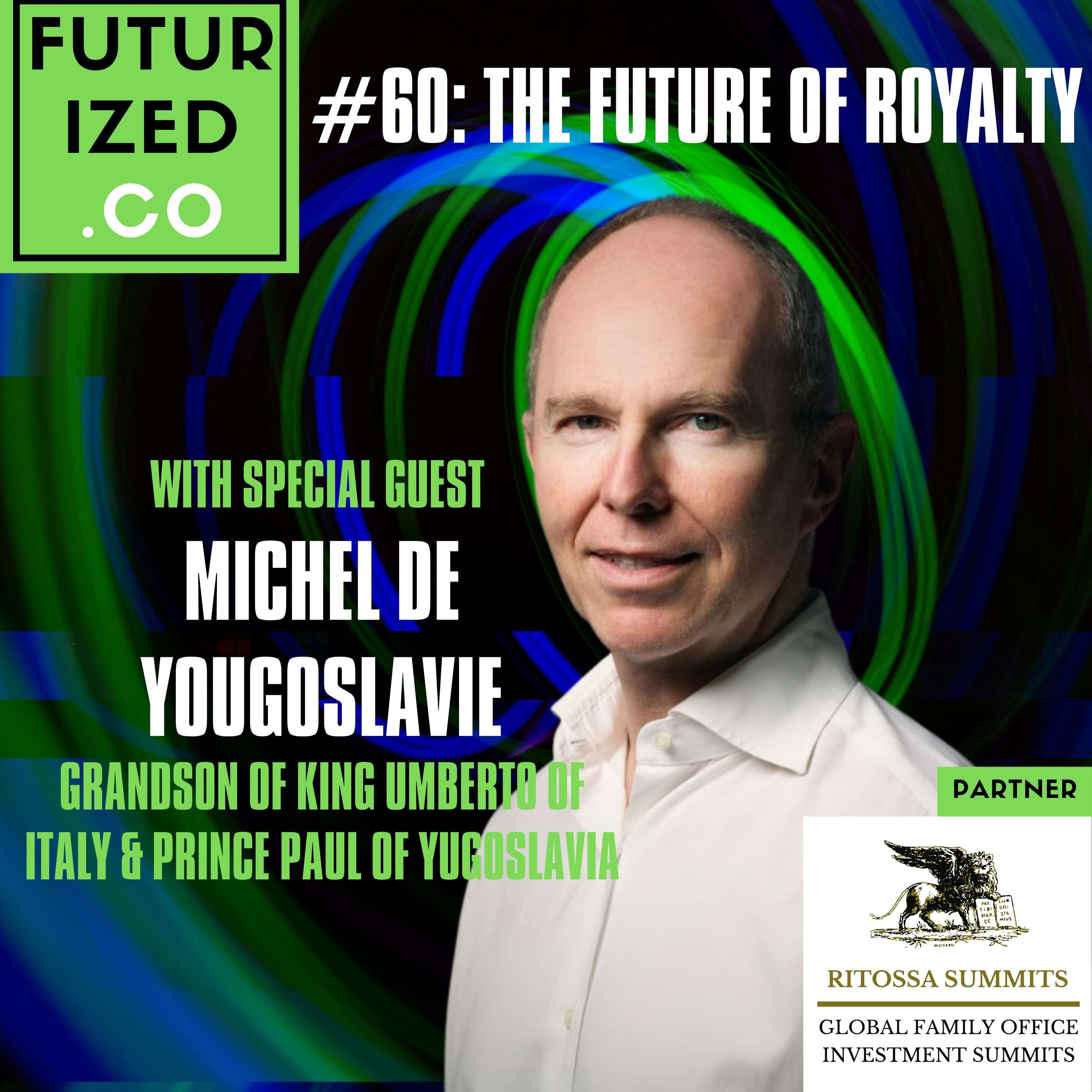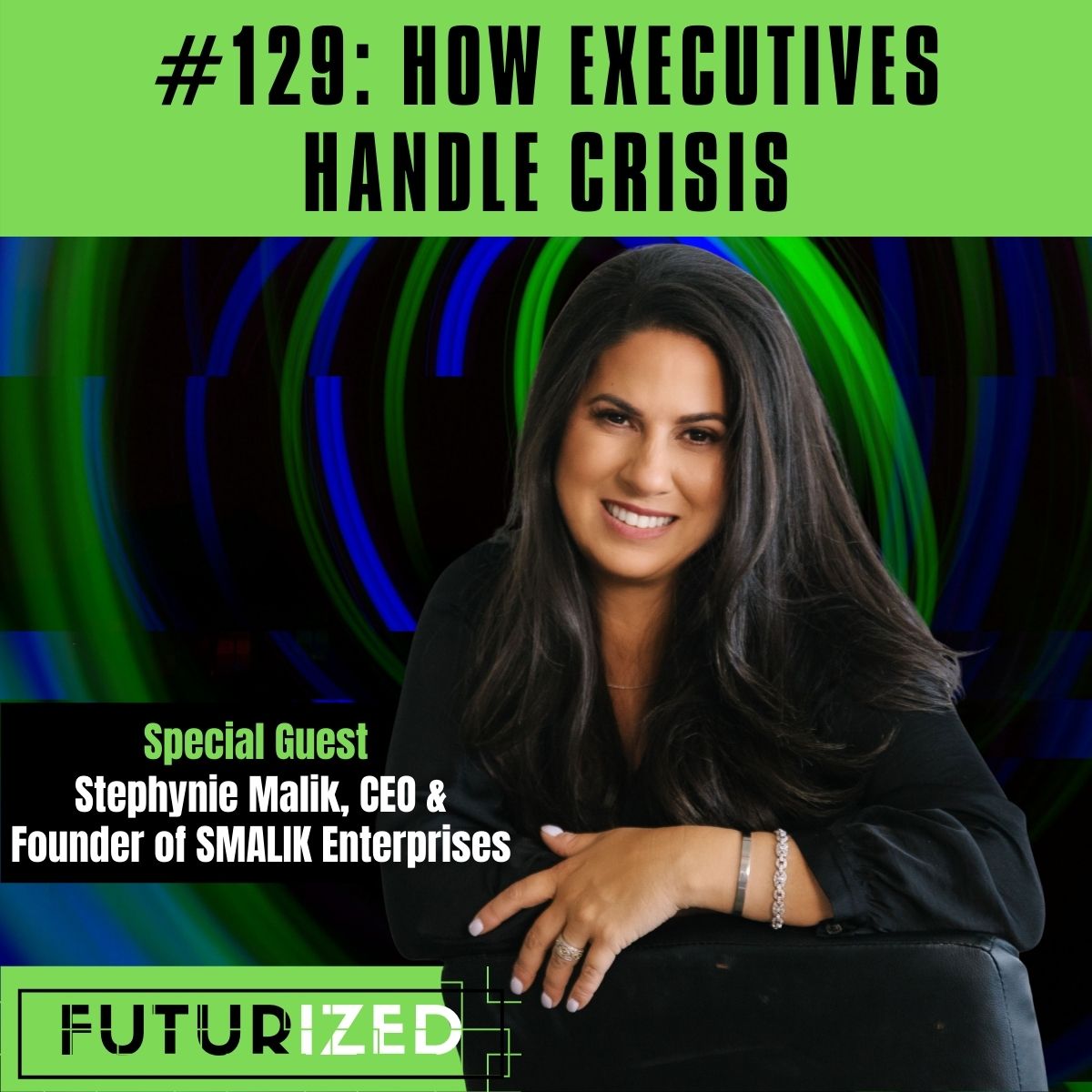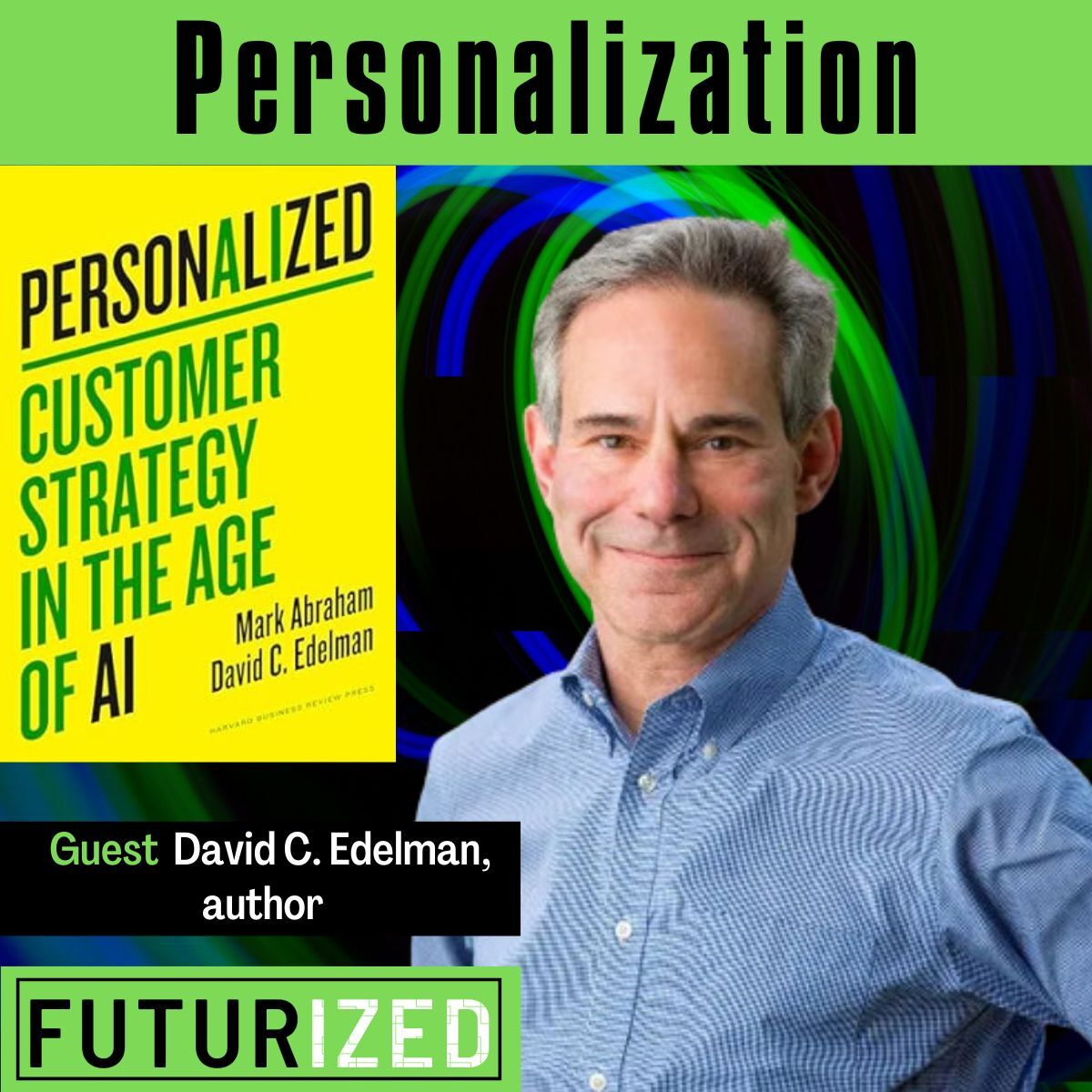Gig Mobility

Ryan Green, CEO & co-founder, Gridwise, interviewed by host Trond Arne Undheim, futurist, investor, and author.
In this conversation, we talk about whether gig mobility services (MaaS) become the standard for how to move in cities? What does the future o...
Ryan Green, CEO & co-founder, Gridwise, interviewed by host Trond Arne Undheim, futurist, investor, and author.
In this conversation, we talk about whether gig mobility services (MaaS) become the standard for how to move in cities? What does the future of driver intelligence look like? We discuss the emerging market size and key verticals such as transportation, city government, real estate, and financial services. We cover disruptive forces and barriers such as COVID-19, security, data protection, and IP. I ask Ryan about the exciting startups he sees in the space and we discuss the next decade's autonomy, data sharing, and mobility-as-a-service adoption.
My takeaway is that gig mobility is becoming the standard for how to move in cities. We are moving into a period with a hybrid fleet of various degrees of human and autonomous driving enabled. The quest for data and the question of who owns it, will also hit transportation. Being a connector between different mobility services is an interesting space to be in, a role one would have expected national, regional and city governments to occupy, but now becoming a battleground for large mobility players as well as emerging startups. Are we at the cusp of the truly smart city? Just maybe but there's going to be dumb infrastructure challenges remining for some years to come.
Having listened to this episode, check out Gridwise as well as Ryan Green's online profile:
- Gridwise (@gridwise_io): http://www.gridwise.io/
- Ryan Green: https://www.linkedin.com/in/ryanagreen/
Thanks for listening. If you liked the show, subscribe at Futurized.org or in your preferred podcast player, and rate us with five stars. If you like this topic, you may enjoy other episodes of Futurized, such as episode 3, The Remaking of Transportation, episode 82, The Future of Grid Energy Innovation, or episode 16, The Future of Human Perception AI.
Futurized—preparing YOU to deal with disruption.
Trond Arne Undheim, Host (00:01):
Futurized goes beneath the trends, tracking, the underlying forces of disruption in tech policy, business models, social dynamics and environment. I'm your host thrown on an untimed, futurist and author in episode 89 of the podcast, the topic is gig mobility. Our guest is Ryan Green, CEO and co-founder of GridWise. In this conversation, we talk about whether gig mobility services become the standard for how we move in cities. What does the future of driver intelligence look like? We discussed the emerging market size and key verticals, such as transportation, city, government, real estate and financial services. We cover disruptive forces and barriers, such as COVID-19 security, data protection and IP. I asked Ryan about the exciting startups he sees in the space, and we discussed the next decades, autonomy data sharing and mobility as a service adoption,
Trond Arne Undheim, Host (00:59):
Ryan, how you're doing today.
Ryan Green, CEO, Gridwise (01:01):
I'm doing great. How about yourself?
Trond Arne Undheim, Host (01:03):
Yeah. It's fantastic. Day to talk about mobility.
Ryan Green, CEO, Gridwise (01:06):
It's always a good day to talk about mobility.
Trond Arne Undheim, Host (01:09):
Yeah. Well, Ryan, you are an interesting guy, us veteran, you Uber driver and founder of a startup. What happened?
Ryan Green, CEO, Gridwise (01:19):
That's such a, that's like the normal path that most people take, right? Yeah. Very, a very non traditional path. I would say to, to get to where I am, but it's I think all those different experiences that I, that I've had brought me to being the co-founder and CEO of GridWise now.
Trond Arne Undheim, Host (01:38):
Well, so what is gig mobility? What, is this idea?
Ryan Green, CEO, Gridwise (01:42):
Yeah, I, I would say is as we think about gig mobility is the way we think about that. It's really kind of defined by the movement of people and goods through in an on-demand fashion. And so when you think of the, the prominent services that are continued to very continue continuously, rapid continue to rapidly grow such as Uber Lyft services on the ride Hill side, or the delivery services like Postmates door dash Instacart for food delivery, grocery, et cetera, is really encompassing is if you think of, you know, the on demand movement of people and goods from point a to point B is we see that that's kind of encompassing of the big gig mobility space because mobility as a whole is, it's a pretty broad, broad ecosystem. So that's kind of the focus area of gig mobility.
Trond Arne Undheim, Host (02:33):
I know, you know as a, as someone in this space, you're gonna probably say that this is going to grow, but when, and how will these types of mobility become kind of the standard for how we move around in cities? It, it obviously, you know, mobility has taken a bit of a hit recently, temporarily, hopefully, but what, what are you seeing and what we'll decide, whether, whether will become indeed just sort of a small part of our mobility, or indeed it's going to move into kind of any, every, any, and every part of the mobility chain.
Ryan Green, CEO, Gridwise (03:10):
Yeah. You know, I think it's if you look at over the past 10 years, I would say, that's, you know, this, these services are definitely trending to become the standard for how, how we move from point a to point B how we consume a food order, food or groceries or things of that, or, and it's, it's hidden an interesting, an interesting point in time with, you know, with everything that's gone on through this, this pandemic that we've gone through, you know, starting in 2022, where you've seen on the, the delivery side, I think people have really deepened the habits around using the food delivery and grocery delivery platforms or the parcel delivery through ordering through e-commerce or things of that sort. And so I think these are this year of 20, the year of 2020 going into 2021 is really defined really defined these companies or these types of delivery platforms is more of a, a standard of, for the time being, and, and, and that may normalize and, and, and, and kind of detract a little bit as things as we get back to whatever this new normal looks like.
Ryan Green, CEO, Gridwise (04:19):
But I do see that, you know, that this is going to be a rapidly growing market from here now on the, on the right Hill side is I think it's really gonna, it's, it's coming down to, you're going to see these services have become more of a standard in urban areas, and we'll take time to expand into the more suburban areas for adoption there. But I mean, you look at nationwide, I believe that ride Hill like total vehicle miles traveled, I think ride Hill only makes a like a couple makes up a couple of percent of those miles. Whereas you look at cities like San Francisco for example, is they make up 23% of those miles which is a big number. And so you're, you're seeing that continuing to grow, and you're going to see that those vehicle miles traveled cover and utilized more more miles traveled within the cities like New York and San Francisco and Chicago and LA.
Ryan Green, CEO, Gridwise (05:15):
And, and that continue to, I think really there's more and more density to cover there in those big cities over the next say, five years. But over the next 10 years, I think is where these services have become solidified themselves as the standard, but they'll also be complemented with other modes of demand, responsive transportation, like shuttles, tramp, micro transit shuttles that are kind of really focused on pockets and zones of the cities or car carpooling services, like the as well. So I think when you bring all of those together, it's just really going to become about this, like on demand. The way we move is going to become about this on-demand multi-modal travel to get to where we need to be. So these
Trond Arne Undheim, Host (05:58):
Smart city discussions, I were was part of them in, in Europe a long time ago, and they have taken a while. And, and, and I think it was always assumed that there was a very advanced public infrastructure that had to be built out before this could take off. But tell me a little bit about even just now, as you are launching what you call, I believe driver intelligence, what sort of data is it that you're basing your Intel and analytics that you're giving to, to the drivers and sort of in, in the net, in the various partner networks that you have you know, with your company, where are you getting all of this data from?
Ryan Green, CEO, Gridwise (06:36):
Yeah. So when we think about the, the analytics that we provide to the drivers is one of those key stakeholders in this ecosystem is our app is really focused on providing analytics that can help drivers make real-time decisions, help them plan ahead for wins the best times to drive based off their personal preferences or, or schedule but also helping them track their performances across all the services they drive for over 70% of them drive for at least two or more services. And, and so really the, when we think of the operational decision-making of when and where I should be driving will work, we're aggregating numerous data from numerous types of sources, such as event feeds, airport, traffic, transit schedules, weather, and other data sources that help us kind of gain a measure for like population density across cities at different times, is that changes.
Ryan Green, CEO, Gridwise (07:28):
And, and so what we're doing in our, in our backend is kind of through our models is we're, we're providing we're processing to duplicating and providing, developing insights to provide to the drivers through real-time alerts based off of their current location of where there may be a nearby opportunity, or there may be an event letting out, which was more relevant before the pandemic as well as our information around airport, traffic, et cetera. And then they're using, they're seeing forecast of a lot of that similar types of those similar types of information through the app and the content that's displayed there, where they can come in and actually see forecasts of airport traffic. They can actually see through recent features, we've put out being able to see kind of how demand is changing across different regions of the city based off of particular types of metrics or particular types of service types, whether you want to, to analyze this from a food delivery standpoint or a ride share standpoint or grocery, et cetera.
Ryan Green, CEO, Gridwise (08:29):
And, and really, so that kind of covers like the operational operational decision-making and the analytics that we provide to support that. And then a big part is really just as, as these drivers are turning those apps on and off on the road, their performance and activity is completely fragmented across the service providers they're driving for. And so what GridWise does is those apps turn on and off as we stay on, and we're able to track their performance across all the services that they drive for. We support about 25 different services now on the ride hail and delivery side, and we aggregate and provide kind of a central source of truth to help them really understand their performance as a gig driver, but also be able to see the breakdowns of their stats across those different services, and then help them track analytics over time of their driving patterns across the city to say like, Hey, here's where I'm getting the most trips from here's where I'm spending the most time without any passenger in my vehicle or any goods, or I'm waiting too long in these particular areas for, to pick up food.
Ryan Green, CEO, Gridwise (09:29):
So there's, there's many types of insights and analytics that we're really just focused on providing to help them just really make, help them make more informed decisions that pretty much directly impacts their, their bottom line or their earnings.
Trond Arne Undheim, Host (09:42):
Brian, I can imagine that this clearly is valuable for a gig mobility driver because you, you simplify their life. You give them analytics, you perhaps help them earn more money. How are you partnering or not with the service providers? Because, you know, if I was an Uber initially, I guess I would say, Hey, Ryan, you're just complicating my life. But then if you think about it in a larger picture, I guess, of course, you'd be like, okay, well, we're not going to be the only one, the only one, unless they do indeed start providing for a hundred percent of a worker's life. Right. But if they still want to continue on this freelancer idea, then clearly the reality is that these drivers are going to have many bosses and, and many, many opportunities. How, how how are you seeing this ecosystem sort of evolve in terms of what, what services and analytics you will provide and what, what these companies will provide? Is there a balance, will you also be starting to supply information back to these these companies, or is this purely an individual service?
Ryan Green, CEO, Gridwise (10:50):
No, it's a great question. I would say that, I mean, the service providers, the service providers themselves is I think they would come out publicly and say to us like, Hey, you're, you're kind of distorting my, our algorithms and the way we're trying to influence where we want our supply of drivers to be, to match passenger demand. But the other challenge, I mean, you spoke to a right. There is the challenge that they're dealing with is that they're, these, these drivers are, are 10 99 contractors. They have multiple services that are driving for, and those services are essentially playing tug of war between them all and all trying to get them to go where they want them to go. And sometimes it's the same place. It's sometimes in a lot of times, it's not. And so really where we see the benefit over time and, and kind of our position is, is in being service agnostic and becoming this service layer and data layer over the ecosystem and the data, the service providers that the service providers who are operating within this ecosystem.
Ryan Green, CEO, Gridwise (11:46):
And so I think is for us is we have a better position to, to really the positively influenced the balance of supply and demand as we have more of a macro or comprehensive view into how all the services are operating in any major city across the U S opposed to just one. And so we do see a world where we're not really focused on providing data back to the service providers. I think that would put us in a sticky, sticky position but as more so I think it developing technologies that enable us to augment their, their operations is where as we're building a fairly large network of drivers that are operating across multiple services is we have the opportunity to be able to allow those services, to plug into our technology or into our systems and say like, Hey, I'm getting passenger requests right now might as soon as the, the, the, the lowest 18 ETA have to this passenger is 13 minutes who is online on my platform.
Ryan Green, CEO, Gridwise (12:48):
But if I ping into GridWise, I actually see that there's dry. There's about six other drivers who just aren't online on my service at this time. And but could provide a two minute ETA for that passenger. And so let me ping this into GridWise and feed this job into GridWise and be able to allow me to have a better, provide a better experience for the customers and, and, and have a lower ETA. And so I, I, I think where I think where we, where we continue to grow is in focuses and building a large network of drivers that can be in, focused on empowering those workers, and then creating ways you know, starting to feed other jobs and opportunities like that into our platform where we allow drivers to earn directly from GridWise as well.
Trond Arne Undheim, Host (13:32):
Wow. So I guess I'm, I'm interested in, in certainly two parts of this network, but, and we've been talking a little bit about these 25 services. Can you give me some details on who are the biggest and mobility providers right now, because it's very easy to just think of, of the kind of Uber, like the taxi type services, but what you're talking about is also the UPS's and and, and the grocery delivery and all that. What are the biggest ones, if you were just going to lay out the, the U S landscape right now, we, which players are, are doing the most business. So, in other words, you know out of the, I think last time we spoke, you said you had 40,000 drivers, and maybe it has increased, but how are they spread on these 25 services?
Ryan Green, CEO, Gridwise (14:20):
I would say is in terms of our, our active drivers, we look at any, in any given quarter, we have over 120,000 drivers is growing growing pretty at a pretty healthy pace. And I would say in terms of the, the service providers themselves, I mean, if you think on, on the ride hail side, that's a pretty, pretty easy go-to where you'd think Uber and Lyft are, are definitely the largest owners of market share there. But when you look at the delivery landscape is, I would say is, it's been interesting. See, I think over the past few years as door dash has become a leader in food delivery is they're, they're owning a very large portion of the market right now. And right behind them would be Uber eats. And then you'll go into Grubhubs Postmates, or are not too far behind those, the in terms of grocery what we're seeing is, is Instacart definitely is the, the market share leader there with companies like Shipt who are, who are growing pretty rapidly, but just aren't up to where Instacart is from a market share standpoint.
Ryan Green, CEO, Gridwise (15:27):
And it'll be interesting to see over the next two to three years of where Cornershop comes into play, which is a really a company that Uber just acquired from South America and, and brought them up into the U S to start operating the grocery component of their business. So that's something that Uber's obviously getting into all of these many, a multitude of, of businesses here. And so I think that they, they may be a significant player because they have distribution through the Uber app already to allow or enable a more rapid growth.
Trond Arne Undheim, Host (15:58):
What about on the supply of of kind of goods and I mail and other things, I mean, are you at all plugged into those, or is it, are you making a distinction between whether they are gig workers or, or, I mean, if they're employees, you, you can't tap into it in the same way.
Ryan Green, CEO, Gridwise (16:16):
Yeah. We, we do make that distinction between gig workers and and full-time employees as we're, we're not plugged into the, the FedEx's or the UPS's of the world, but we are, I would say, plugged into the, the movement of goods through Amazon flex or through roadie or two companies there. And then you'll see Postmates is, is, has gotten into the movement of, of everything as well. And so we do, we do cover the, those services is where you see, I mean, Amazon flex is really fulfilling, so many different types of jobs, whether they may tie into some of the prime now or grocery delivery things, as well as the the, the parcel delivery of, of fulfilling Amazon, the delivery of Amazon packages. And then Roddy's really built a B2B business that maybe delivering lost luggage from the airport or delivering, you know, you may want to deliver something to a friend and you just request that from roadie and the driver will take that to wherever it needs to go. Hmm.
Trond Arne Undheim, Host (17:15):
What are the disruptive forces in this market for you right now? So w what, you know, is it the technology that is driving things right now? Is it more in regulation which you're watching? Is it these sort of creative, new business models that you and others are creating around the analytics, or, or is it more the response on the social dynamics of it all? In other words, you know, the response in the, into consumer markets to, to all of these emerging services, which obviously are evolving a little bit as, as the analytics, the drivers are changing
Ryan Green, CEO, Gridwise (17:50):
To where, what impacts the market the most right now? Yeah, I would say is from a software standpoint or technology, I think that's what what's enabled, enabled the acceleration of these services, the acceleration of growth of these services to be where we are now. But I do think that as we, the market is somewhat matured in terms of the adoption of these types of services, which still has a long way to go or a big opportunity at hand to grow into is I think a lot of is coming down to how the services optimize and how these services really kind of expand their business, their lines of business there. So they, you know, I mentioned Uber getting into grocery and they they just required drizzly for alcohol delivery. There's, they're really taking this approach of building a kind of wide variety of services and solutions.
Ryan Green, CEO, Gridwise (18:43):
So, but when we think of the optimized side of things, I do think it does come down to the data and how you can leverage data to optimize and enhance the way you operate services, how you, how you price and the price mechanics becomes so critical of how you think about compensation for the gig workers, how you incentivize them, how you price on the writer, the writer side of the equation as well. And how is that changing across the entire landscape in, you know, on a daily or even a, on an hourly or intraday basis. And so I think it's becoming very critical to have a purview into, like, what, what is happening across this ecosystem and how are these trends changing to be able to best operate and expand your, your business. The, at the same time, I, I think a driving force that is disrupting the industry and hasn't disrupted a yet, but is, is on the cusp of being able to is, is really just the, the, the rights and benefits provided to the gig workers.
Ryan Green, CEO, Gridwise (19:50):
I mean, there's just debates day in and day out. As we saw like Reggie legislation come out of California related to the AB AB five, or prop 22 propositions in, in, in kind of forcing the, the gig services to provide more benefits and minimum wage standards and, and things of that sort. But I think is what we're seeing is there's. I think what we're seeing in this industry is that there's there's W2, or 10 99 is, is, are two structures that have worked, but may not work with the new type of work that is really growing in the gig economy. And so that there's, there's not a good solution out there. That's really providing the most adequate or equitable benefits or wages or compensation to these workers now. And what you're seeing is just these debates sprouting up across every city in the U S is, is after California did this, it's popping up in New York, it's popping up in other.
Ryan Green, CEO, Gridwise (20:47):
And so I think the service providers are really going to be, they're going to have their, they have their hands full in dealing with these issues. And there's in over the next, you know, one, two, three years. I think there'll be some significant changes that come about based off of really the industry recognizing that the way that the services are operating and and kind of have structured their relationships with gate workers is just not the right way to do this right now. And so I think based off of whatever the outcome is that that could significantly impact or disrupt the way that these services operate in, in, in the U S
Trond Arne Undheim, Host (21:24):
It would seem to me though that in the U S the solution is fairly simple. I mean, the amount of minutes you're logged into a provider you know, the company can't compensate you less than minimum wage per hour. I don't understand how that, that would be a baseline principle. I mean, why would there be a discussion about that?
Ryan Green, CEO, Gridwise (21:46):
Yeah, I mean, I there's there shouldn't, it should be pretty clear and simple. I think it's, it's the challenges, obviously that the service providers are facing is that they're, they're trying to strive towards profitability. They don't, they're not close to being profitable. The ambition they have ambitions to be at by the end of 2021. And so they're fighting this, this battle of it's like, Hey, we've, we're a public company. Now we're trying to get to you know, investors have a keen eye on us. We're trying to get to profitability, but at the same time, it's like, you know, any changes to our economics are there are our structure here is going to deter from that. So how do we kind of bring all of that together? And that's where the, I think that the challenges is between the companies and the actual workers. I, I do think that another challenge is when you think of the, the offline, like the, the online time had been compensated a minimum wage for that is like, the other challenges that I mentioned earlier is that these drivers are they're, they're bouncing between multiple apps.
Ryan Green, CEO, Gridwise (22:47):
And so, as they're doing so is there's a lot of time where, like, is, it is someone who has been an Uber driver themselves, what I would do, and what other drivers do is it, you, you may be taken out far into the suburbs and you're, you're, you're taken out there and you're going to turn off your app at that point and go offline, because you don't want to be subject to getting another trip so far out that takes you even further outside the city that will maybe prevent you from actually having a ride back into the city at all. And so what you do is you turn off your app and then you drive back to where you think is the best place to position yourself. And so at that point, you're, you're still working your, your, your intention is to work for the service, but you're just repositioning yourself. And so that's where I think for, as we're going through, and we're starting to work with, with researchers and other stakeholders in this ecosystem is we're trying to shed light into how, as we capture that entire work time, even when they're there offline or offline, it doesn't matter a GridWise perspective. We care about when do they start working, and when did they stop and, and seeing like, what is that full duration of work time that they're actually accumulating to tie into their, their wages, as opposed to just online time?
Trond Arne Undheim, Host (23:59):
Can you map out some of the other startups that are operated in this space and, you know, I'm just going to list off some, and I'm sure that they all have very different takes on whether they're on the analytics side, on the fleet side of this question. So, you know, grade-wise, is your company move it to moval immense Moby Leo duffle, geo shore. I mean, some of these are our more geographical systems. Others, I guess, are a little bit similar to yours, generally, the startup space around mobility. What are some of the exciting things that you're seeing? I mean, you don't have to talk about specific companies if you're uncomfortable with that, but what are the kinds of things that you're seeing popping up?
Ryan Green, CEO, Gridwise (24:38):
Well, I mean, you see, you see companies like move it, who've grown to be massive companies with adoption from hundreds of millions of consumers. And they've done an amazing job of standing up these kinds of multi-modal multi-modal platforms where you can access multiple modes of transportation from one particular application. I think like in terms of the, the lay of the land now in our space, I mean, we're seeing actually more companies pop up that are trying to do similar things to what we've done or what we've kind of paved the pathway of it is really around gig and power gig worker empowerment. And some of them are taking the approach to be more broader in the, in the gig worker spectrum in, in way they empower those workers, whereas like a company like GridWise, we're very focused on gate drivers per se, and the movement of and, and those drivers who are focused on the movement of people and goods and services, I would say in terms of other other technologies or applications outside of like the, the gig worker space or gig worker empowerment, I would say is there's, there's other like loyalty rewards platforms that have, that have come into play that are really trying to allow you to earn points and redeem those points for, and transfer those into cupboards those in the flight miles or discounts at, at retail stores or things of that sort.
Ryan Green, CEO, Gridwise (26:01):
And by, based off of how many Uber Lyft rides you take and or other rides you take on other other types of services or how much you use other types of services. And so I do feel that there is still a gap and a gap for a company that can kind of be the, the kayak of the on demand, transportation, or gig gig mobility side of things. And, and there's some companies that have, I think have done a, a great job, like a company called amigo Jeff who runs a company there. Their challenge was is that they actually closed deals with Uber and Lyft and connected into them in addition to many other providers across the country. But as soon as Uber and Lyft went public, they actually cut off their feeds and, and actually didn't allow them to connect because they didn't want price comparisons happening as they were trying to mask the prices more to consumers.
Ryan Green, CEO, Gridwise (26:57):
And so what they've had to do is go to Europe where those companies are still open, open for them. There is a little bit more fragmentation and they're operating there and actually able to they're doing pretty well in, in, in that sense of, of aggregating all those services and allowing consumers to choose kind of the best ride that they want to take at that time. So that's something that I feel like is still missing in the U S from the consumer standpoint there, but those are some of the technologies. Some of the technologies that I would say we're seeing from a, at least a mobile standpoint, but they're, they're all are others outside of that, that are kind of focused on the broader. There's been a large spark over the last few years of companies who are focused on the analytics side of things, where they're providing transportation analytics and, and, and providing insight to to help empower cities, make better policy decisions or infrastructure decisions.
Ryan Green, CEO, Gridwise (27:54):
And there's a lot of those like city focused platforms that have popped up that have really tied into the mobility data specification feeds that allow you to consume scooter data and bike share data and others. And then they're trying to the data's accessible, but they want to help cities and others visualize that and, and be able to kind of really plan creating a user experience where they can like plan their infrastructure and simulate different types of decisions that they may be trying to make. So that's a, been a big wave as well.
Trond Arne Undheim, Host (28:27):
What about if you look more, long-term like next decade type of things. I mean, some of these startups and yourselves, hopefully we'll be around and we'll have changed the landscape by then in terms of sort of autonomous driving. I mean, I could think about, you know, on the data side, there's going to be, hopefully these battles about who owns, so which data is going to be settled. There's going to be a bunch of new business models, perhaps. What do you see happening? Large scale? I mean, first off is, is this segment growing so fast that, you know, 10 years from now? I mean, what, what kind of traffic are you, are we looking at and, and, you know, to, to address this autonomous segment how much traffic is you, do you think be autonomous by that time?
Ryan Green, CEO, Gridwise (29:16):
Yeah, I mean, I think 10 years is a good like over the next 10 years is you'll you? I think we'll start to see more commercialization of the autonomous systems is a lot of the focus right now is on freight. And I think where there's going to be the, the, the quickest or the most rapid speed to commercialization there from there, I think we'll start to see more autonomous systems that are kind of tying delivery and movement of goods and kind of the last mile sense. And then in the latter part of that deck the decade is, is getting more into the commercialization of, of where you're actually moving people. But we obviously know that's where the most liability is. There's going to be the most friction from a consumer sentiment standpoint, but also from a regulatory standpoint.
Ryan Green, CEO, Gridwise (30:02):
But I do think is I don't, I don't think that the, the human drivers necessarily, or would be will go away in the next 10 years. And you're going to see quite a hybrid market. There's going to be so many different types of scenarios where it makes sense for a human to complete this job or to, or task or delivery and other times where it's going to make sense for an autonomous vehicle to do that. And, and so I think is that's going to be a big as those services come into play is there's going to be a lot around just like how those, how they compliment each other and how you operate a network that may have a hybrid of both autonomous and humans, but also maintain, you know, equitable and fair rights for the human workers and not, you know, showing that you're just kind of displacing them completely.
Ryan Green, CEO, Gridwise (30:52):
So I, I do think that is I mean, we'll see more and more autonomous modes of in systems over the next 10 years. I do think that the, the data privacy and data sharing component of, of this is, is another disruptor over the next 10 years to see is just how you're seeing a lot of, a lot of restrictions come into play, especially from a mobile app standpoint of where Apple and Google are, both locking down on Android are both really kind of locking down on how location is shared and how accessible people's location are, which has been a huge driver into the understanding of, of, of this movement of people and goods and, and consumers and foot traffic and so many things. And so it's really going to redefine the way that we can actually, like the question comes to be is like, how do we leverage our first and other types of data when that data that we've been leveraging over the past eight or so years is, is more inaccessible.
Ryan Green, CEO, Gridwise (31:53):
And data is really just becoming the key driver and key force to any of these companies that are coming out, whether autonomous or human driven fleet to help them understand how to best expand their services, how to best price them, how to best allocate their fleet and understand where it from an autonomous standpoint, where should might be, it will be stationed at, or staging at, at any given time to make sure that it's not like there's butts butts in that seat as much as possible that the vehicle is utilized. So it's really, it's going to be an interesting landscape, but I think it's gonna be a very data-driven decade to really build and maintain these systems, but also to make the changes from a municipal or a city standpoint, to make the changes in infrastructure that are needed to this. Because I think that's where one of the biggest gaps are and where cities have struggled and understanding how, you know, how our curves are being utilized. How do we better monetize the curb and how do we change our infrastructure to actually adapt and make for more seamless flow of these types of on-demand services that aren't inducing congestion, which have been said to be doing so right now,
Trond Arne Undheim, Host (33:03):
One of the things you said early on was you started this company on what part of what you're doing is to augment and empower the frontline worker. The frontline worker has been embattled right during COVID. And also generally, if you think of technology development, it hasn't always been that the kind of automation or the kind of technology that we put in place hasn't necessarily always been a net positive effect for, for sort of the end the worker at the end of the line, the worker that's in front of, in front of you, the worker, that's usually taking more risks and, and we've talked about the compensation issues and other things, was that part of the motivation when you started this company, I mean, obviously you start a company, you you're trying to create a business model that has moat, but what was part of your frustration as a, as a driver? Was it related to this empowering or is that more of a side effect?
Ryan Green, CEO, Gridwise (33:58):
And by empowering, you're asking for the empowering of, of workers.
Trond Arne Undheim, Host (34:00):
Yeah, because I mean, right now it seems like what your solution is doing is essentially empowering the gig economy drivers to take a little bit of the power back from essentially from the companies in the sense that they have more data, so they can make wiser decisions in terms of their own Workday. And, and it's, I find it an interesting example of, you know, a trend in technology now, which you see in factories and other places where these could have like no or low code platforms are actually enabling workers to make some choices about how they're going to go about their work, where they're getting immediate feedback, so they can adjust as opposed to just giving the factory itself or the owners, the data four weeks later. So they can say, well, actually this lot of group, you know, were workers could be laid off because they're inefficient and that other right. Instead, you're actually putting the data in front of the individual. So they themselves can make these day to day and minute by minute decisions that affect their salaries, their I guess, comfort in, in their Workday. And a lot of interesting, you know, I would say good development.
Ryan Green, CEO, Gridwise (35:03):
Yeah. I would say since, since in coming into GridWise, our focus was empowerment of, of the, the drivers in terms of when we thought about that, we saw where made most sense to start was in focusing on helping them make the best operational decisions related to what's happening in the city at any given time. We didn't really understand coming into it. You know, what are all the ways that we can empower workers? But what we started to see is that, like, I think something that was very surprising early on is we, we, that we could build a set of, you know, a feature or two that would really apply to 80 or 90% of the drivers out there and be valuable to them. What we started to see is that drivers are the personas of drivers are, there's so many of them and they're broken up based off of their personal, their personal schedules.
Ryan Green, CEO, Gridwise (35:58):
The, the, whether they're full-time versus part-time their personal preferences related to driving. Some of them will never drive and wait at the airport. Others will like always, they live by it. Others will not drive late nights, others drive mornings, and sort of like their strategies are really just kind of all over the place. And so to really be, to empower those workers where we saw as like we needed to create more of a an experience that is, it becomes a companion across your entire journey and supports the use cases of so many different personas of drivers to help them really make the most well-rounded decisions. But then from there, what we learned is that we needed to not only provide analytics, but we saw, you know, as we've seen that drivers really lack benefits, but like for one service provider to provide benefits, it's very difficult.
Ryan Green, CEO, Gridwise (36:44):
But when you're a service that really is encompassing of drivers across all services, your position to really provide benefits in a unique way that can be as applicable to drivers across all services across the ecosystem. And so where we've seen as outside of the analytics is that it's really what we're starting to build now is more of a marketplace of services as well on that, provide them income protection or discounts on gas, or we're building out more insurance and financial products or things of that sort that really focused on providing the benefits that they're missing, but would be difficult to just receive from one service when they're trying to work for many services.
Trond Arne Undheim, Host (37:20):
Mm, wow. It's a, it's a fascinating new and emergent economy that just has shown up over the last few years. It's interesting. Well, thank you so much for sharing these insights. I hope we can we can stay in touch. I guess the last little question is, is simply if I have a listener who tries to track or understand, or even get in on this game of gig mobility what are the places where, where this kind of thing is tracked? I mean, are there bloggers that are influential in this space? So what sort of consulting companies have you know, stood up reports that are tracking this field?
Ryan Green, CEO, Gridwise (38:00):
Yeah, I would say is maybe a shameless plug here is one one of them is, is, is us as GridWise analytics from a blog standpoint, if you're trying to understand the industry or the space or how the trends are changing in this space, I would say we're we're with our insight in this space, that would say it's more comprehensive than anybody else in this industry is we're a very good resource for that. There's others out there, other blogs such as the rideshare guy, that's become a strong influencer in the space that speaks a lot about not just rideshare, but just the big gig economy and the trends associated with his ball. And then you see a lot of other I think large consultancy, like the top consulting firms. They write a lot of white papers. Some of the large banks, like Goldman Sachs are writing a lot about this space as well. But also is I'm seeing kind of the I'll stop there. Cause I lost my train of thought there. Great. That's great.
[edited]
Trond Arne Undheim, Host (39:34):
So Ryan, I was just curious about, as you're tracking this field, you obviously GridWise is a, is a good resource in and of itself, but can you mention just a couple of other sources that might be useful for people tracking the gig mobility space?
Ryan Green, CEO, Gridwise (39:48):
Yeah, I would, I would say outside of, of GridWise and kind of where we're tracking from a what we call GridWise analytics and our blog that exists there is I would say others, others in the space. You can think of the, the rideshare guy he's become a pretty prominent influencer in this space is doesn't only speak about rideshare, but also speaks about the gig economy as a whole and, and trends associated with within it. Any some interesting interviews with like the CEO of Uber and some executives at other service providers as well. The in addition to that, I mean, there's a lot of white papers that are being produced from the large consulting firms. You think of Deloitte or bane or companies like that are really covering the mobility space, but also you think of there surprisingly is like company, like MasterCard are really focused in this space and thinking about how, you know, transactions are playing out in the gig economy and how this is shaping up. And I think a lot of interesting reports about the gig economy as a whole they've come out with, even over the past year. In addition to some of the large banks like Goldman Sachs are writing a lot about the future of mobility and, and there's a lot to learn from those white papers as well.
Trond Arne Undheim, Host (41:03):
Well, thanks a lot, Ryan. This was a great conversation. I wish you best of luck as we move ahead. And I hope we can touch base the economy here changes by the minute. So I'm sure a year from now we'll have a lot of different news. I hope so.
Ryan Green, CEO, Gridwise (41:17):
Well, thanks for having me today, Trond.
Trond Arne Undheim, Host (41:20):
You have just listened to episode 89 of the futurize podcast with host Trond Arne Undheim, futurist and author. The topic was gig mobility. And this conversation we talked about whether gig mobility become the standard for how to move in cities. What does the future of driver intelligence look like? We discussed the emerging market size and key verticals, such as transportation, city, government, real estate and financial services. We covered disruptive forces and barriers, such as COVID-19 security, data protection and IP. I asked Ryan about the exciting startups he sees in the space, and we discussed the next decades of autonomy, data sharing and mobility as a service adoption. My takeaway is that gig mobility is becoming the standard for how to move into cities. We are moving into a period with a hybrid fleet of various degrees of human and autonomous driving enabled the quest for data. And the question of who owns it will also hit transportation.
Trond Arne Undheim, Host (42:21):
Being a connector between different mobility services is an interesting space to be in. A role, one would have expected national, regional, and city governments to occupy, but now becoming a battleground for large mobility players, as well as emerging startups. Are we at the cusp, the truly smart city, just maybe that there's going to be dumb infrastructure challenges remaining for some years to come. Thanks for listening. If you'd like to show, subscribe at Futurized.org or in your preferred podcast player and rate us with five stars. If you like this topic, you may enjoy other episodes, a future such as episode three, the remaking of transportation, episode 82, the future of grid, energy, innovation, or episode 16, the future of human perception. AI, futurizing preparing you to deal with disruption.

Ryan Green
CEO & co-founder
Ryan Green is a former US veteran and Uber driver who founded Gridwise. Gridwise is creating a smarter mobility grid by empowering on-demand drivers, cities, and mobility stakeholders with mobility analytics solutions. The Pittsburg startup was founded in 2016.
















































